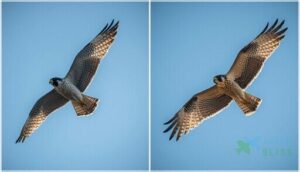This site is supported by our readers. We may earn a commission, at no cost to you, if you purchase through links.

You spot a raptor circling overhead, but identifying whether it’s a falcon or hawk isn’t as simple as most field guides suggest. These aerial predators share the same sky, yet they’ve evolved into fundamentally different hunting machines—each shaped by millions of years of specialization.
A falcon’s entire anatomy, from its notched beak to its tapered wings, centers on one breathtaking skill: the high-speed stoop that can exceed 240 mph. Hawks, by contrast, built their success on patience and crushing power, using broad wings to soar effortlessly while scanning for ground prey.
Understanding these differences transforms casual birdwatching into reading an ancient language written in bone structure, flight patterns, and predatory tactics that reveal why one bird ambushes from a perch while another strikes from a vertical dive.
Table Of Contents
- Key Takeaways
- Falcon Vs Hawk: Key Differences
- Wing Shape and Flight Patterns
- Hunting Strategies and Diet
- Habitat, Range, and Nesting
- Classification and Conservation Status
- Frequently Asked Questions (FAQs)
- How do you know if a falcon is a hawk?
- What is the difference between a hawk and a Falcon?
- Can a hawk fight a Falcon?
- Why do Falcons flap their wings faster than Hawks?
- Is a Falcon a Sea Hawk?
- Do Falcons fly faster than Hawks?
- What is the difference between a falcon and a hawk?
- Can a falcon pick up a dog?
- Who is stronger falcon or eagle or hawk?
- Do falcons eat squirrels?
- Conclusion
Key Takeaways
- Falcons are built for extreme speed with pointed wings, notched beaks, and diving attacks that exceed 240 mph, while hawks rely on broad wings for patient soaring and crushing talon strength to ambush ground prey.
- You can distinguish these raptors by their head shape—falcons have compact, rounded skulls with a distinctive facial “mustache” stripe, whereas hawks show slender, elongated heads with smooth, curved beaks lacking the falcon’s signature tomial tooth.
- Wing structure reveals each bird’s hunting strategy: falcons use high aspect ratio wings (6-7) for high-speed aerial pursuit of birds, while hawks employ lower aspect ratio wings with separated primaries for maneuvering through forests and riding thermal currents.
- Despite superficial similarities, falcons (Falconidae family, 65 species) and hawks (Accipitridae family, 256 species) evolved separately, with falcons originating in South America during the Paleocene epoch and developing fundamentally different anatomical adaptations for survival.
Falcon Vs Hawk: Key Differences
You might spot a hawk and a falcon perched on the same cliff and wonder what sets them apart. At first glance, they seem like close cousins, but their differences run deeper than you’d think.
Let’s break down the key physical traits that separate these two raptors.
Size Comparison
When you compare hawks and falcons, size differences stand out. Hawks generally measure 18–30 inches in overall length, while falcons range from 8–26 inches. Body mass also varies—large female hawks can exceed 3 pounds, whereas most falcons stay lighter. However, interspecific overlap exists: some medium hawks match larger falcon species in body sizes. One key difference lies in their beaks, with falcons having a distinctive beak with a tooth.
| Feature | Hawks | Falcons |
|---|---|---|
| Length | 18–30 inches | 8–26 inches |
| Wingspan | 17–55 inches | 29–47 inches |
| Body Mass | Up to 4.5 lbs | Up to 3.3 lbs |
Head and Beak Shape
You’ll notice hawks display slender, pointy heads built for perching and scanning, while falcons show short, rounded heads optimized for high-speed dives. The real difference lies in beak morphology. Falcons possess a sharp tomial tooth—a notch near the beak tip that severs prey spines mid-air. Hawks lack this hunting adaptation; their beaks curve smoothly, relying on powerful talons for kills instead. Both birds of prey share similar plumage, though subtle differences exist. similar plumage is common.
| Feature | Hawks | Falcons |
|---|---|---|
| Head Shape | Slender, pointy | Short, rounded |
| Beak Structure | Smooth curve | Tomial tooth notch |
| Cranial Profile | Broader, elongated | Compact, aerodynamic |
| Killing Method | Talons-first | Beak-assisted |
Plumage and Color Patterns
Beyond head and beak, plumage reveals deeper distinctions. Hawks exhibit greyish-brown feathers with pale, striped undersides—though western red-tailed hawks show striking color morphs ranging from light to dark rufous. Falcons display bluish-grey plumage with black-barred wings in females. Age differences matter: juvenile peregrine falcons show brown streaks, while adults develop steel-blue upperparts. You’ll spot falcons by their bold facial markings—that distinctive dark “mustache” stripe below the eye.
| Feature | Hawks | Falcons |
|---|---|---|
| Base Color | Greyish-brown tones | Bluish-grey dominance |
| Pattern Type | Pale striped underside | Black-barred wings |
| Color Morphs | 3 distinct western forms | Minimal polymorphism |
| Facial Markings | Subtle, undefined | Bold mustache stripe |
| Geographic Variation | Strong (10-20% dark morphs) | Stable across range |
Wing Shape and Flight Patterns
When you watch a hawk and a falcon in flight, you’ll notice they move through the sky in completely different ways. Their wings tell the story—each shape is built for a specific style of hunting and survival.
Let’s break down how their wing structure, flight speed, and soaring versus diving behaviors set these birds apart.
Wing Structure and Adaptations
Wing shape reveals each bird’s flight strategy. Falcons have high wing aspect ratios—around 6–7—with long, narrow wings and smooth, pointed tips. You’ll notice their primary feather slots are minimal, cutting drag for high-speed dives.
Hawks show lower aspect ratios, broader wings, and finger-like separated primaries that boost lift at low speeds, perfect for maneuvering through trees and soaring on thermals.
Flight Styles and Speed
Ever wonder why falcons seem to slice through the sky while hawks circle with patience? Falcons use pointed wings and low wing loading for blistering flight speed—up to 69 mph in pursuit and 200 mph in a dive.
Falcons slice through the sky at blistering speeds up to 200 mph, while hawks circle patiently on broader wings
Hawks, built for soaring styles, conserve energy, gliding at 20–40 mph. Their flight patterns reflect distinct hunting styles and migration speeds.
Soaring Vs Diving Behaviors
How do these birds master the skies? Hawks rely on soaring mechanics, riding thermal currents for long stretches with minimal energy expenditure. Falcons, in contrast, specialize in hunting dives—using flight adaptations for astonishing diving speeds, sometimes topping 240 mph.
Each flight style matches their hunting techniques: hawks scan and glide, while falcons weave through air, striking with precision mid-dive.
Hunting Strategies and Diet
Regarding hunting, falcons and hawks each have their own style. You’ll notice some sharp differences in how they choose prey and make the catch. Here’s what sets their strategies and diets apart.
Prey Selection
Think all predatory birds chase the same prey? Not quite. Falcons, like peregrines, favor medium-sized birds, especially in cities where urban diets shift toward pigeons. Hawks, on the other hand, often target mammals—red-tailed hawks go for rodents, while Accipiters hunt songbirds.
Prey size and habitat shifts shape each species’ hunting strategy, revealing their unique bird diet preferences.
Killing Methods (Talons Vs Beak)
Regarding killing methods of birds, you’ll see a clear divide. Hawks rely on sheer talon strength and asphyxiation tactics—those powerful feet crush and suffocate prey.
Falcons flip the script: they use impact force during the stoop, then dispatch victims with a surgical beak serration and spinal severance.
Each hunting strategy is precision at work.
Hunting Techniques and Agility
When you compare hunting techniques, falcons dominate through extreme aerial speed. Peregrines hit 242 mph in stooping dives, tripling capture success to around 31% against agile prey.
Hawks blend strategies: stooping mechanics and rolling grabs boost their hunting success to 43% per bout.
Each bird’s aerial maneuvering and agility outcomes reflect specialized adaptations—falcons excel in high-speed intercepts, while hawks master adaptable perch and pounce tactics.
Habitat, Range, and Nesting
Where a bird of prey lives shapes everything about how it survives. Hawks and falcons have carved out very different niches across the globe, from dense forests to wide-open tundra.
Let’s look at where you’ll find each bird, how far their ranges stretch, and where they choose to raise their young.
Preferred Habitats
You’ll find hawks and falcons have distinct habitat preferences that reflect their hunting styles. Hawks thrive in forests, woodlands, and mixed habitats with perches for scanning ground prey. Falcons prefer open country like grasslands, tundra, and coastal areas where their speed shines.
Both species show considerable habitat overlap in urban environments—48% of midwestern peregrines nest on high-rises, while red-tailed hawks adapt to city parks with suitable perches.
Geographic Distribution
Both hawks and falcons demonstrate striking global distribution across every continent except Antarctica. You’ll discover these raptors occupy diverse avian habitats shaped by latitudinal patterns and biome segregation.
Regional examples reveal their stunning reach:
- Peregrine falcons breed from Arctic tundra to tropical coasts worldwide
- Indonesia harbors 116 raptor species—21% of Earth’s total
- South America’s Andes concentrate the highest hawk and falcon densities
- North America hosts 25 native hawk species versus just 6 falcon species
- Red-tailed hawks occupy habitats from Canada through Mexico
Continental presence peaks in equatorial mountain systems where habitat preferences of hawks and falcons overlap most dramatically.
Nesting Locations and Materials
Once you know where these raptors live, you’ll want to understand their nesting habits. Falcons create shallow scrapes on cliff ledge nests between 25 and 1,300 feet high, laying eggs directly on bare rock without added materials.
Hawks build elaborate stick nests in tree nest heights of 13 to 115 feet, lining interiors with bark strips. Both species follow distinct reuse patterns across multiple breeding seasons.
Classification and Conservation Status
Understanding where hawks and falcons fit in the family tree helps you see just how different these raptors really are. Beyond taxonomy, both birds face real threats that put their survival at risk.
We’ll look at how they’re classified, what dangers they’re up against, and whether their populations are holding steady or slipping away.
Taxonomy and Species Groups
Understanding avian classification helps you distinguish these striking raptors at their core. Here’s how taxonomy separates them:
- Family Classification: Falcons belong to Falconidae (65 species), while hawks sit within the larger Accipitridae family (256 species).
- Subfamily Diversity: Falconidae has 3 subfamilies; Accipitridae contains 12.
- Genera Comparison: True falcons (genus Falco) include 37 species; hawk genera exceed 70.
- Species Count: Accipitridae shows greater diversity overall.
- Evolutionary Origins: Falcons arose in South America during the Paleocene epoch.
Threats and Conservation Efforts
Both raptors face serious threats despite their fierce reputations. Pesticide poisoning devastated peregrine falcons—DDT nearly wiped out eastern populations by the mid-1960s. Today, habitat loss and electrocution risks on power lines kill hundreds annually. The IUCN lists several hawk species as vulnerable or critically endangered.
Recovery programs have helped, releasing over 6,000 peregrines since 1974. Trade regulations under CITES protect falcons from illegal capture for falconry.
Population Trends and Protection
Following decades of DDT impacts, peregrine populations surged over 10% in recent surveys—New York alone counted 72 breeding pairs by 2013. Yet sharp-shinned hawks dropped 92% at some sites, facing lead poisoning and habitat loss.
Climate change now threatens both families. The IUCN flags seven hawk species nearing extinction, pushing conservation efforts to protect critical nesting grounds before more populations collapse.
Frequently Asked Questions (FAQs)
How do you know if a falcon is a hawk?
You can’t identify a falcon as a hawk—they’re distinct families.
Key differences between hawks and falcons include beak morphology: falcons show a tomial tooth, while hawks have smooth, curved beaks for visual identification.
What is the difference between a hawk and a Falcon?
Hawks and falcons differ primarily in size, wing shape, and hunting style. Hawks are generally larger with broader wings for soaring, while falcons have pointed wings for speed and aerial pursuits.
Can a hawk fight a Falcon?
Like boxers in different weight classes, hawks and falcons can clash over territory defense or prey, though combat triggers are rare.
Size advantage generally determines fight outcomes, with larger species dominating through enhanced killing methods and hunting techniques.
Why do Falcons flap their wings faster than Hawks?
You’ll notice falcons flap their wings faster because their high-speed wing design and higher wing loading demand rapid, powerful strokes to sustain lift during level flight and agile aerial chases, unlike broad-winged hawks that glide effortlessly.
Is a Falcon a Sea Hawk?
No, a falcon isn’t a sea hawk. “Sea hawk” refers to the osprey, which belongs to a completely different family. Ospreys dive for fish, while falcons hunt birds in flight.
Do Falcons fly faster than Hawks?
When you compare flight, speed measurement methods show falcon speed records far surpass hawk gliding efficiency.
Aerodynamic differences and wing shape evolution let falcons reach over 300 km/h in dives, while hawks rarely exceed 190 km/h.
What is the difference between a falcon and a hawk?
It’s strange how two birds can share the sky yet live worlds apart. You’ll spot key differences between Falcon and Hawk in their Visual Identification, Size Variations, Behavioral Traits, Evolutionary History, and even their unique Cultural Significance.
Can a falcon pick up a dog?
You won’t see a falcon picking up a dog. Falcon lifting capacity maxes out around 5 kg, while most dogs far exceed that.
Raptor attack risks are low; their prey profile favors birds, not mammals your dog’s size.
Who is stronger falcon or eagle or hawk?
If you’re wondering who rules in raw power among birds of prey, eagles stand alone. Their grip strength, prey size, and dominance potential far outmatch hawks or falcons.
Hawks vs falcons? Hawks are stronger, but eagles reign.
Do falcons eat squirrels?
Yes, falcons do eat squirrels, especially Prairie Falcons in the western U.S. Squirrel predation evidence shows ground squirrels form a major part of their diet, though species diet variation and geographic dependence shape hunting strategies of birds of prey.
Conclusion
Test the theory next time you see a shadow overhead: is it the swift falcon or the patient hawk? Watch the flight—does it slice the air or ride the wind? Notice the beak, the talons, the hunting style.
The falcon vs hawk debate isn’t just about names; it’s about decoding nature’s blueprint. Each bird is a living answer to survival’s challenge, and when you recognize their differences, you’re reading a story millions of years in the making.
- https://www.treehugger.com/difference-between-hawks-and-falcons-6753915
- https://afjrd.org/hawk-vs-falcon-key-differences/
- https://merzougabirding.com/falcon-vs-hawk-8-differences-explained/
- https://a-z-animals.com/animals/comparison/falcon-vs-hawk/
- https://betterwithbirds.com/blogs/bird-identification/falcon-vs-hawk









